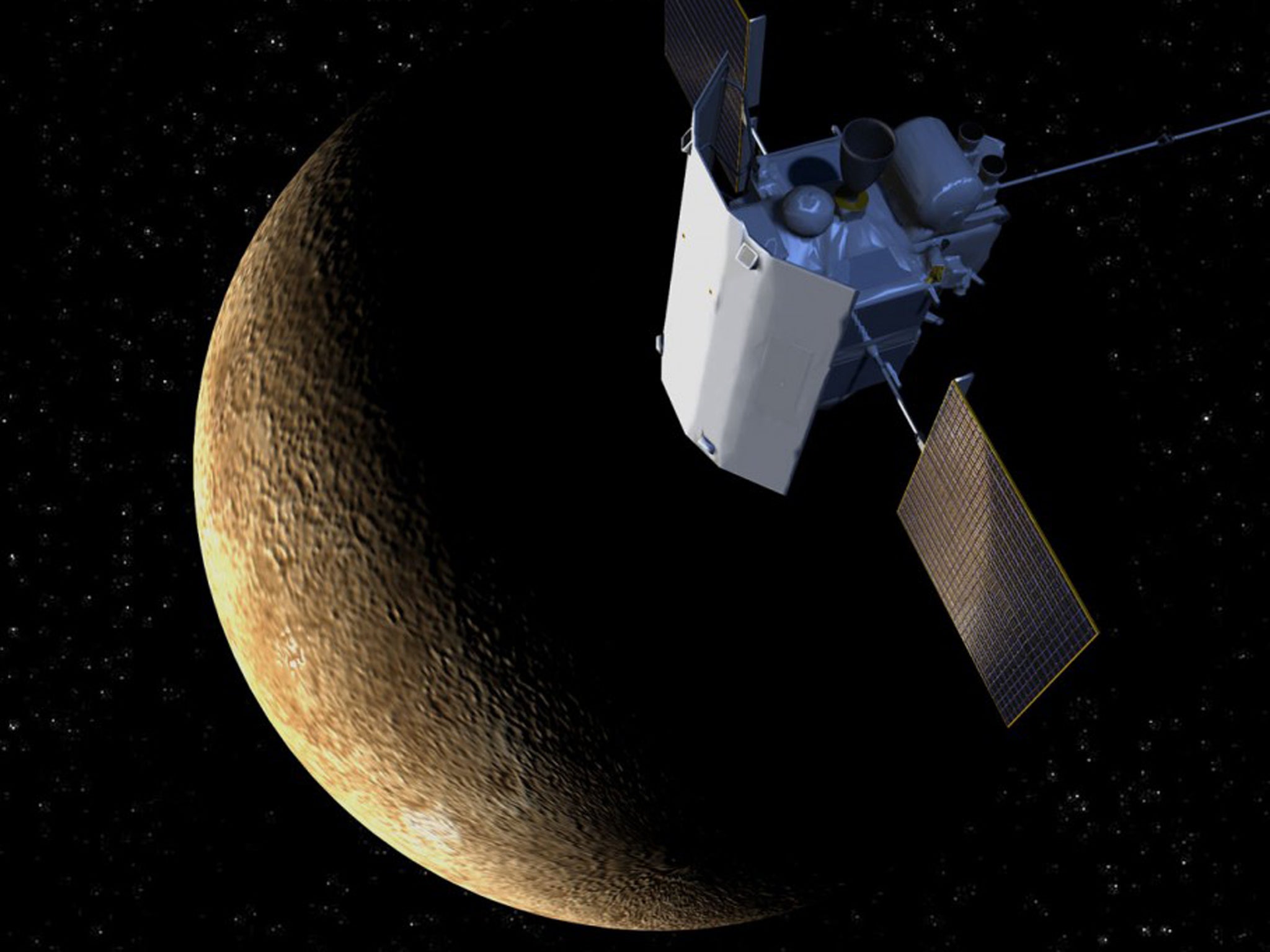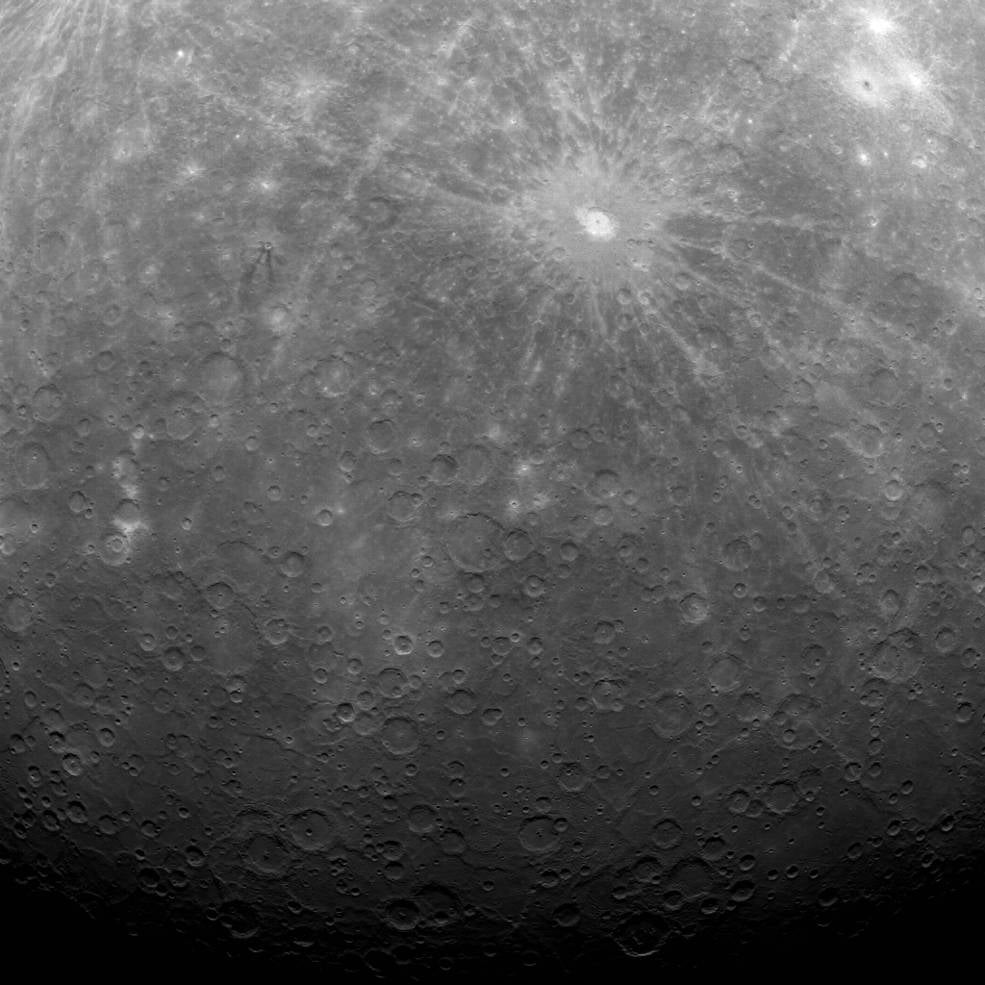Nasa's Messenger Capsule to smash into Mercury and die, ending a life of pioneering discovery
'It’s like losing a member of the family,' the mission head has said about the loss

It’s been a wild ride for MESSENGER, the NASA spacecraft that has offered mankind its best insight into the mysteries of Mercury. Just 10 feet long and no heavier than a Friesian cow, the tiny ship has traveled 5 billion miles, flown by three planets and completed the first-ever map of the “first rock from the sun.”
That all comes to a crashing conclusion Thursday, when the ship is due to perish in a massive impact with the planet it so diligently documented, according to the space agency. MESSENGER is about 10 and a half years old.
“It’s like losing a member of the family,” mission head Sean Solomon toldScientific American.
NASA knew this day was coming. The craft ran out of propellant last winter and has been slowly spiraling toward Mercury’s surface ever since.
Since then, the only thing keeping MESSENGER aloft was the creativity of the scientists who run it. After exhausting the liquid propellant used to keep the craft in motion, the team jerry-rigged an alternative source of fuel from the helium used to maintain pressure inside the ship’s gas tanks.
It was the first time anyone had tried to extend a spacecraft’s life this way, Stewart Bushman, lead propulsion engineer for the mission, told Astronomy Magazine. Finding replacement fuel is so rarely necessary, since something else almost always goes wrong on a spacecraft first.
But MESSENGER’s life story has been one of defied expectations.
The spacecraft, whose name stands for MErcury Surface, Space ENvironment, GEochemistry and Ranging, launched in August 2004. It was the first mission in nearly 30 years dedicated to studying the planet closest to the sun. Its predecessor, Mariner 10, was able to photograph just half the planet in a handful of flybys before running out of fuel and losing radio contact with Earth.
This time, scientists said, the spacecraft wasn’t just going to zoom past Mercury and snap some photos. MESSENGER was scheduled to spend a full year in orbit around the little-studied planet, mapping its surface, probing its atmosphere and investigating its interior.
“It took technology more than 30 years … to bring us to the brink of discovering what Mercury is all about,” Solomon said in a State Department press release issued the day of the launch. “By the time this mission is done we will see Mercury as a much different planet than we think of it today.”
Solomon was right, possibly more so than he could have imagined.
After journeying 5 billion miles through space, conducting multiple flybys of Earth, Venus and Mars, MESSENGER pulled into Mercury’s orbit on March 17, 2011. A little over a week later, it sent home the first ever image of Mercury taken from orbit. The photo showed a vast, gray, pockmarked expanse of rock, seemingly even more barren than the moon.

But the MESSENGER mission revealed that there was much more to Mercury than meets the eye. Beneath that bland, gray exterior, the planet has a massive, spinning iron core that generates its magnetic field. Unlike Earth’s core, this one appears to be liquid and huge — about 85 percent of the planet’s radius.
That boiling liquid rock is entirely beneath the planet’s surface, but among MESSENGER’s other discoveries was that, in its early years, Mercuryseethed with volcanic activity. Scientists used to think that the planet lacked the “volatile compounds” needed for explosive eruptions, believing that such molecules were either fried or blasted away during Mercury’s formation. But evidence that volcanoes did explode, and that some of those “volatiles” still remain, meant that scientists had to reconsider their assumptions about the planet’s origin.
“This research is revolutionizing our thinking about the early history of the planets and satellites,” Jim Head, a MESSENGER mission co-investigator, said in a press release about the study.
Other surprises from MESSENGER’s four years in orbit include the observation of seasons within its barely-existent atmosphere, the realization that the planet is contracting as it cools and the discovery of unexplained, shallow “hollows” marring the planet’s surface.
One of the mission’s biggest headlines came in 2012, when MESSENGER provided absolute confirmation that there is ice on Mercury. Given the planet’s wispy atmosphere and dangerous proximity to the sun (Mercury’s orbit brings it three times closer than Earth’s and subjects it to solar rays that are 11 times as strong), it seemed a poor candidate for finding water, particularly in frozen form. But for years, telescope observations kept revealing strange bright patches at the planet’s poles.
MESSENGER gave scientists the first opportunity to examine those patches up close. What they found surprised them: Because the planet doesn’t tilt on its axis, there are pockets at the poles that never see sunlight. In those pockets, researchers found clumps of ice accumulated beneath a layer of dark, organic material. Not life, but something on the way to it.
“I don’t think anybody could count Mercury as habitable,” Solomon told Scientific American. But that organic material — “the ingredients for habitability,” as Solomon called it — must have come from somewhere. How it wound on Mars is a mystery space researchers are itching to solve.
“Those polar regions, I think, are calling out to people … and saying, ‘Send us another spacecraft, we have more stories to tell,’” Solomon told the LA Times.
All the while, MESSENGER took more than 270,000 images of Mercury’s surface, helping NASA to produce the first-ever complete map of the planet.
The year-long orbital mission was so successful that NASA extended it in 2012. The use of helium to propel the craft helped extend its lifespan even further, allowing scientists to collect more data. Even now, as the craft hurtles toward its doom, MESSENGER is beaming data to researchers back on Earth.
In this undated photo provided by NASA, technicians with The Johns Hopkins University Applied Physics Laboratory in Titusville, Fla., prepare the MESSESNGER spacecraft for a move to a hazardous processing facility in preparation for loading the spacecraft’s hypergolic propellants. (NASA via AP)
One of the last transmissions was a series of spectrometer images showing variations in the minerals that make up the planet’s crust.
Since Mercury has an insubstantial atmosphere, MESSENGER won’t burn up as it descends. Instead, it’ll crash into Mercury at a speed of about 2.5 miles per second, according to Scientific American, adding its own small impact crater to the hundreds that pock the planet’s surface.
It’s a bittersweet end for the researchers who have spent over a decade following the spacecraft from afar.
“We’re at the end of a really successful mission, and we can’t do anything anymore to stop it from doing what it naturally wants to do,” Thomas Zurbuchen, a member of MESSENGER’s science team, said in a statement. “The sun is pulling on it. The planet is pulling on it. It’s just physics. It has to crash.”
Copyright Washington Post
Join our commenting forum
Join thought-provoking conversations, follow other Independent readers and see their replies
Comments